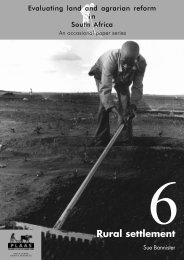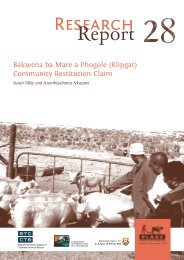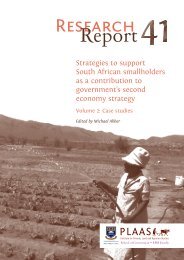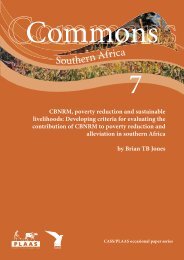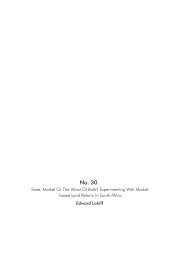A critical appraisal of South Africa's market-based land reform policy
A critical appraisal of South Africa's market-based land reform policy
A critical appraisal of South Africa's market-based land reform policy
You also want an ePaper? Increase the reach of your titles
YUMPU automatically turns print PDFs into web optimized ePapers that Google loves.
Chapter 7: Conclusions<br />
Vele project does not represent a route to<br />
<strong>land</strong> ownership that a person with more<br />
modest resources could take.<br />
All the young people and almost all the<br />
women beneficiaries are members <strong>of</strong><br />
group projects, whereas the individual<br />
beneficiaries are almost exclusively older<br />
men. This indicates the difficulty women<br />
and youth will have in benefiting individually<br />
and the important role that group<br />
projects can play in benefiting the marginalised.<br />
All the beneficiaries interviewed,<br />
with the exception <strong>of</strong> the women from<br />
Mankweng Integrated project, were reasonably<br />
well-<strong>of</strong>f and could certainly not<br />
be described as poor.<br />
Despite not fitting the descriptions <strong>of</strong><br />
how <strong>market</strong>-<strong>based</strong> programmes are meant<br />
to work, experience in Limpopo has confirmed<br />
the concerns <strong>of</strong> critics that it is the<br />
richer and more powerful who will benefit<br />
the most from LRAD. This has happened<br />
not so much because <strong>of</strong> their wealth, but<br />
because <strong>of</strong> their access to information<br />
and political influence. Far from endeavouring<br />
to bring poorer people into the<br />
programme, DLA and the DoA have gone<br />
out <strong>of</strong> their way to benefit those already<br />
better <strong>of</strong>f and already benefiting from<br />
state <strong>land</strong>, while making access to the<br />
programme expensive (in time and<br />
transport) for poorer people, and almost<br />
totally inaccessible for the very poor.<br />
A number <strong>of</strong> the larger farms at Steilloop<br />
and the one at Roedtan are already<br />
generating a reasonable income for the<br />
beneficiaries, and it would appear that this<br />
could be improved substantially with further<br />
investment, training and support. The<br />
Manamead farms may not be viable as<br />
stand-alone enterprises, but they could be<br />
more productive with increased investment<br />
and improved commitment to the project<br />
from the beneficiaries. The <strong>land</strong> at Manamead<br />
also appears to be adding value for<br />
some farmers as part <strong>of</strong> a broader and<br />
more complex set <strong>of</strong> farming and business<br />
activities.<br />
The difficulty <strong>of</strong> obtaining access to<br />
finance was a complaint from almost every<br />
beneficiary, and was seen as a major<br />
constraint to their operations. In a bizarre<br />
twist, even the quite wealthy beneficiaries<br />
are still struggling to get finance to<br />
improve their operations and unlock the<br />
potential <strong>of</strong> the <strong>land</strong>. It is unfortunate that<br />
the opportunities provided by LRAD to<br />
inject additional capital, over and above<br />
the purchase <strong>of</strong> <strong>land</strong>, were not taken.<br />
What has been hidden by the LRAD<br />
statistics, especially when averages are<br />
calculated, is that this is actually a two-tier<br />
programme. There are group projects<br />
accessing very small portions <strong>of</strong> <strong>land</strong><br />
(averaging 8.24ha per beneficiary, see<br />
Table 2) and individuals obtaining large<br />
tracts <strong>of</strong> <strong>land</strong> (averaging 679ha each).<br />
Most <strong>of</strong> the larger individual farmers have<br />
already accessed the maximum or close to<br />
the maximum grant, while the members <strong>of</strong><br />
group projects all received the minimum<br />
grant. Despite the concept <strong>of</strong> ‘graduation’<br />
(NDA 2001:6) there is no reasonable<br />
opportunity for beneficiaries to move from<br />
lower to higher-level operations – the gap<br />
is just too great. In practice, beneficiaries<br />
are not aware <strong>of</strong> the possibility <strong>of</strong> ‘graduating’<br />
to better things, nor is anything being<br />
done to structure projects that could enable<br />
this step up.<br />
The projects approved have some merit<br />
as tenure upgrades in the context <strong>of</strong> past<br />
insecure tenure rights. Especially in the<br />
case <strong>of</strong> Steilloop, a number <strong>of</strong> the farmers<br />
are reasonably successful and they are the<br />
type <strong>of</strong> emerging black middle class<br />
farmers that many in <strong>South</strong> Africa believe<br />
should receive support. It is hard to envisage<br />
a situation in <strong>South</strong> Africa today<br />
where black farmers who have been<br />
leasing state <strong>land</strong> for years could be<br />
moved in order to make way for others.<br />
Providing them with formal ownership <strong>of</strong><br />
the <strong>land</strong> makes a lot <strong>of</strong> sense and perhaps<br />
in the future will encourage greater investment<br />
in the <strong>land</strong>. The Vaalkop project also<br />
has logic as a tenure upgrading project for<br />
the families living on the <strong>land</strong> – the <strong>land</strong><br />
and the grants they would potentially have<br />
access to could be used for development<br />
projects. However it seems that these kinds<br />
43







